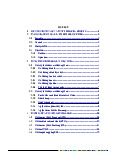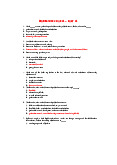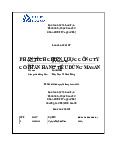



















Preview text:
AsiaCALL Online Journal Received: 20/10/2021
ISSN 1936-9859; https://asiacall.info/acoj Revision: 26/02/2022 Vol. 13, No. 2, 2022 Accepted: 09/03/2022 pp. 1-20 Online: 13/03/2022
Online education at Saigon University during the COVID-19 pandemic: A survey
on non-English major college students’ attitudes towards learning English
Tran The Phi1*, Nguyen Trinh To Anh2
1 Department of Foreign Languages, Saigon University, Vietnam
2 Department of Foreign Languages, Saigon University, Vietnam
*Correspondence: Tran The Phi, Saigon University, Vietnam. E-mail: tranthephi@sgu.edu.vn
* https://orcid.org/0000-0001-6608-5594
https://doi.org/10.54855/acoj.221321 Abstract
The outbreak of Covid-19 has forced educational institutions to initiate online teaching to
maintain the process of student learning at all levels. This paper focuses on online education
at Saigon University, during which the local government has been mandating social
distancing in most of the regions. This paper aims to investigate the students' attitudes
towards using online learning tools, which are comprised of learning management systems
(Moodle and digital support for core materials) via virtual classrooms (Google meet). A
survey questionnaire was designed to evaluate attitudes towards using the above online
teaching and learning package from 222 non-English major undergraduates who took part in
General English courses at Saigon University in July 2021. The results indicate that a
majority of students show favorable attitudes towards online education; in the meantime,
health and social issues also concern their learning process. Some recommendations are also
offered for improving the efficiency of the online education process at Saigon University.
Since the study focused on non-English major college students, it is hoped to have particular
relevance to other institutions of higher education.
Keywords: Online education, non-English major college students, attitudes, learning
management systems, higher education, Saigon University 1. Introduction
The outbreak of coronavirus disease (Covid 19) -
and its rapid spread into a worldwide
pandemic has greatly affected people in any job field. There existed a substantial
infrastructure for online education in many countries before the pandemic (Mishra et al.,
2020). However, no university was ready for a complete shift to online education. Students
missed the help they received from their peers in classrooms and laboratories and access to
the library (Patricia, 2020). Nevertheless, students felt that online education helped them to
continue their studies during the pandemic (Mishra et al., 2020). Universities were now using
innovative strategies to ensure continuity of education for their students (Zhu & Liu, 2020).
CITATION | Tran, T. P., & Nguyen, T. T. A. (2022). Online education at Saigon University during the COVID-19
pandemic: A survey on non-English major college students’ attitudes towards learning English. AsiaCALL Online
Journal, 13(2), 1-20. DOI: https://doi.org/10.54855/acoj.221321 https://asiacall.info/acoj
Tran The Phi & Nguyen Trinh To Anh Vol. 13; No. 2; 2022
The government has strongly supported the use of information technology (IT) in schools and
universities through initiatives ranging from primary schools to higher education that has
encouraged the acquisition of laptop computers for students and teachers under favorable
conditions and secured broadband connections in all public establishments. Lecturers are now
delivering course content through various platforms. They were using online educational
platforms, videoconferencing software, and social media to teach their courses (Patricia,
2020). Online educational platforms, like Google Classroom and Blackboard, allow lecturers
to share notes and multimedia resources related to their courses with students. The online
educational platforms also allow students to turn in their assignments and teachers to keep
track of the progress of the students. Videoconferencing tools, like Google Meet, Zoom, and
Microsoft Teams, help in organizing online lectures and discussion sessions. Some
universities are also disseminating course material through their websites and their own
learning management system (Mishra et al., 2020). Moodle can be considered an open source -
platform that 'educators can use to create effective online learning sites' (Moodle, n.d.).
In order to deal with the outbreak, Ho Chi Minh City authorities have imposed social
distancing measures since the end of May 2021 due to a dramatic rise in the number of
infection cases. At Saigon University (SGU), the summer semester from mid June - to August
2021 was taught online, using online educational platforms including Moodle, E-zone for
textbooks, and video conferencing tools, namely Google Meets.
However, students were able to encounter some challenges or difficulties when learning
online English classes in SGU. According to Octaberlina and Muslimin's findings (2020),
students faced three difficulties during online learning: unfamiliarity with e learning, - slow
internet connection, and physical condition, such as eye strain. Similarly, students believed
that online education was difficult and had a negative impact on their health and social lives
(Chakraborty et al., 2020). Accordingly, when the implementation of online learning was too
urgent, and there was not sufficient training, non-English major students of SGU might have
more concerns and unfavorable attitudes toward online educational platforms when taking part in English classes. Research Questions
Considering the present situation and previous research, our study intends to uncover the EFL
students' attitudes and the challenges towards the implementation of English online education.
To fulfill the purpose of the study, the survey sought to answer the following research questions: 1. What are -
non English major learners' attitudes toward online education in SGU in
terms of content delivery, interaction, and testing and assessment?
2. What are their difficulties or challenges when taking part in online education in SGU? 2 ACOJ- ISSN 1936-9859 AsiaCALL Online Journal Vol. 13; No. 2; 2022 2. Literature review The Covid 19 -
pandemic has forced various educational institutes and schools to suddenly
modify their workflow strategies and adopt new technologies. In most cases, these
organizations did not get enough time to reflect upon how the new strategies and the
corresponded technology should be introduced and integrated into their existing setup (Carroll
& Conboy, 2020). Bao (2020) described how universities were moving from classroom based -
education to online education because of the raging pandemic.
In particular, blended learning is regarded as an innovative way of teaching and learning
English in which teaching and learning activities have been completely supported by
information technology (David, 2014). Siirak (2008) argues that blended learning with
computer-based learning in the Moodle E-learning environment, based on social constructivist
learning theory, is an effective tool for teaching and learning in the occupational health and
safety discipline. In fact, using Moodle in teaching develops learners' communicative skills in
language and requires social interaction between the teacher and students and among the
students themselves (Al-Ani, 2013). A large number of studies on using Moodle in teaching
and learning English were implemented in the past few years (Brandle, 2005; Irina & Laura,
2007; Stewart, 2007; Al-Ani, 2013; Tang, 2013); however, there has been little research on
using Moodle in teaching translation modules thus far.
For those reasons, researchers have tried to understand the viewpoint of students on online
education during the COVID-19 pandemic using empirical studies in India (Mishra et al.,
2020) and the USA (Patricia, 2020). Students in this research had good opinions regarding
online English learning using the LMS Moodle, despite it being their first time using Moodle.
Overall, one survey conducted by Carvalho et al. (2011) revealed that students appeared to
value the contribution of an LMS to their learning, seeing it as a supplement rather than a
replacement for traditional classroom activities.
Another study (Cinkara & Bagceci, 2013) investigated learners who took part in the online
course using Moodle at a state university in south eastern - Turkey indicated a relatively
positive attitude toward the course in accordance with the learners' scores from the uniquely-
designed Online Language Learning Attitude Test (OLLAT). This study pointed out how the
differences of male and female learners and their self-perception of computer literacy skills
impacted their learning attitudes.
Sinaga and Pustika (2021) explored the attitude of SMK Yadika Bandar Lampung students in
Turkey towards learning an English subject via Moodle, considering the characteristics of
their thoughts, feelings, and behavior. It was a nice result that students showed a positive
attitude to implement Moodle as a learning platform during the period of the Learning from Home program.
Here are certain studies conducted in Vietnam concerning learners' attitudes towards online
learning of English. At UEH in Vietnam (Duong, 2020), some students even expressed their 3 https://asiacall.info/acoj
Tran The Phi & Nguyen Trinh To Anh Vol. 13; No. 2; 2022
enthusiasm for this method of teaching and learning because of the benefits it provides,
among which concerned non-education related factors (e.g., transport cost-saving, time-
saving). Duong also noted that one of the initial impressions English professors had of
teaching online was that the students were more engaged in class participation. The researcher -
in ULSA2 (Nguyen, 2022) found that non English -
major students generally had a positive
attitude about learning through video conferencing, with significant differences in attitude
across gender, technical proficiency, and competencies. Nguyen concluded with high
confidence that undergraduate students are eager to study a variety of courses online.
Although online learning is welcomed, the encounter of difficulties is inevitable. Those were
indicated in the studies of Nguyen et al. (2021) and Ngo (2021). 3. Methods
3.1 Pedagogical Setting & Participants
Saigon University (SGU) first pioneered Learning Management Systems - SGU Moodle in
2019. Since then, it has steadily been promoted among 19 faculties, providing training for
basic technical practices. Alongside, teachers are required to attend real-time meetings with
students via Google Meets, which also allows teachers to save recorded meetings directly to
Google Drive and share with students to help them stay up to date on lessons. Furthermore,
the core textbook (i.e., Helbling material) provides students with digital support from the
online educational platform. This study has examined the adoption of these three platforms,
hereby called online education platforms, in SGU during the summer semester.
This study selected samples by a convenient sampling method. The participants were 222
non-English major EFL students of Saigon University, Vietnam, recruited from all faculties
(excluding English majors). The vast majority of students (50.5%) were between the ages of
18 and 19, which was typical of first-year undergraduate students who were required to enroll
in this course. Yet, this course also attracts a high percentage of sophomores (39.7%),
equivalent to the group of 20 - 21 (42.7%). In terms of gender, the percentage of female
students is superior to the proportion of male students (63.9% and 39.1%, respectively).
Despite the fact that all areas of study were covered (Figure 2), over half of the participants
majored in Business Management and Commerce (37.3%) and Information Technology
(18.9%), whereas about 20 percent enrolled in pedagogical studies and education. Details of
the participants' backgrounds are presented in Figure 1. 4 ACOJ- ISSN 1936-9859 AsiaCALL Online Journal Vol. 13; No. 2; 2022
Figure 1: Participants’ demographic information
3.2 Design of the Study
Based on qualitative research and referring to previous studies, we synthesized, analyzed, and
quantified attribute factors in designing a quantitative questionnaire for participants. This questionnaire presente
d respondents with a series of questions or statements to which they
were to react either by writing out their answers or selecting from among existing (Brown,
2001). It employed attitudinal questions, which are used to find out what people think. This
instrument was appropriate to the research purpose (i.e., attitudes) while it was cost-effective
and versatile. In addition, questionnaires enabled researchers to collect data from a large
number of correspondents, and instrument homogeneity is frequently associated with higher
reliability (Mackey & Gass, 2005). The questionnaire was based on the model which was
used to examine the influence of various aspects of online education on social issues related to
online education suggested by Chakraborty et al. (2020) when they conducted a survey in an
Indian university. However, for this study
- focused on learning and teaching-related factors,
we ignored the impact of health issues and social issues.
We surveyed the students who had completed the General English course - Module I in the
summer semester of 2021. The survey was categorized into 3 groups of questions concerning
(1) students' demographic information, (2) students' evaluation of the effectiveness of the
online education platforms, and (3) their challenges/difficulties of online education.
3.3 Data collection and analysis
The questionnaire was distributed online using the Google Forms tool, and the respondents
were collected two weeks after. The Google Forms tool was used to administer the survey
electronically. Email invitations to respond were sent out during the following two weeks
when the course had finished. We received 222 respondents, which is equivalent to a response
rate of about 50%. Cattell (1978), Gorsuch (1983), and Tanaka (1987) suggested that in
behavioral analysis, the sample size should be chosen from 4 to 10 times as many as the
number of variables in the questionnaire to ensure representativeness. Accordingly, the size of our sample is satisfactory.
In the first section, biographical data was collected and the level and major of studies.
Especially, the last items of this part identified the participants' level of English proficiency, 5 https://asiacall.info/acoj
Tran The Phi & Nguyen Trinh To Anh Vol. 13; No. 2; 2022
continuing with their needs for learning English, preferences for different contents of English,
and expectations of taking the course. Necessities and expectations of learning English
contribute to the evaluation of students' attitudes toward the learning process and methods.
Belcher (2009) notes that needs analysis can exploit diverse, infrequently conflicting views of
a large number of stakeholders.
In the second part, we asked the students to evaluate the effectiveness of online education
based on their experience during the course. There were 18 positive statements related to
content delivery, interaction and testing, and assessment employed by each tool of the
package. A student had to respond to each survey item on a 5-point Likert scale, and their
responses are coded as: strongly agree = 5, agree = 4, neutral = 3, disagree = 2, strongly disagree = 1.
The third section required the students to score their satisfaction with the whole course,
ranging from favorable to disappointed. They were asked to give feedback on how online
learning benefits their proficiency of English in pronunciation, vocabulary and grammar use,
and 4 major skills. They were also asked to identify the problems or challenges they faced
during the online sessions concerning teacher and student related - factors. Therefore, in the
final part, the students were encouraged to make recommendations for a better online learning experience.
4. Findings and discussion
4.1. Demographic analysis
The demographic variables of students presented in this section include age groups, gender
characteristics, areas of study, self-assessment of English proficiency levels, their preferences
in learning English, and their expectations for the course. Understanding how they have
facilitated their online learning, regarding where they were studying and which technological
devices were used, is important.
Learning English background
Their level of English proficiency also fluctuated from Beginners to Advanced, as shown in Figure 2. 6 ACOJ- ISSN 1936-9859 AsiaCALL Online Journal Vol. 13; No. 2; 2022
Figure 2: Participants’ self-assessment level of English proficiency
Gladly, more than 90% found learning English necessary and showed positive attitudes
towards expectations for the course, which aim to serve their communicative competence
(Figure 3). Most of the respondents (85.5%) expected to improve knowledge (of vocabulary
and grammar) and macro skills of using English which is helpful for their future career,
although 78.7% aimed to pass course tests and exams according to the curriculum's
assessment. Goal setting has both motivating and informational effects on learning and self-
evaluation. Students who set goals are more likely to pay attention in class, put forth the
effort, and persevere. These motivational effects result in increased on-task behavior and
learning speed. Specifically, the number of students (more than 60%) who aimed at listening
and speaking skills were slightly higher than those (around 50%) whose aim was reading and
writing. Accordingly, Figure 4 presented the students' preferences for certain main English
learning components. The results indicated that a majority of respondents expressed
preferences with all components. 60%
Figure 3: Participants’ needs of learning English 7 https://asiacall.info/acoj
Tran The Phi & Nguyen Trinh To Anh Vol. 13; No. 2; 2022
Figure 4. Participants’ expectations of taking the EGP course Studying facilities
Figure 5. Technological equipment used for studying online
80% of them had been participating in online learning while they were at their permanent
residence, of which 46.6% were living in Ho Chi Minh City (HCMC), and 33.4% were in
their hometown outside HCMC. However, due to the pandemic, few of the students (2.8%)
had to study while they were staying in the quarantined areas. Wherever they were, each of
the participants equipped themselves with at least one piece of technological device to access
the course, and their favorite ones are laptops and smartphones or both at one time.
Figure 6. Location of studying online 8 ACOJ- ISSN 1936-9859 AsiaCALL Online Journal Vol. 13; No. 2; 2022
4.2. Descriptive results of the effectiveness of online education
In general, as can be seen in Figure 7, 23.1% of students found the online course highly
recommended, and more than half found the course fairly good, while 21.3% agreed that the
course was satisfactory. Nevertheless, only a few of them (less than 5%) showed
disappointment with the course. The effectiveness of online education regarding content
delivery, interaction, and testing and assessment will be discussed in detail.
Figure 7. Participants’ general evaluation of the online course
4.2.1. In relation to content delivery
The teacher's use of Moodle to share available core course materials timely was well received -
by nearly 90% of the students. A high proportion of 85% agreed that the course was a user-
friendly design in which the summary of the course enriched the classes. 81% expressed how
they thought lectures could be made more informative. During the online sessions via Google
Meets, slideshows were also deemed effective in distributing knowledge to the students. Also,
the students (86%) also appreciated the meeting-recording functions of Google Meets, which
helped them keep up when they had missed a session.
In addition, more than half of the participants had experienced E-Zone learning provided by
the core textbook. Over 80% agreed or strongly agreed that the cloud book and e-book had a
friendly-user design and that they were interested in a variety of exercises.
The students received the teachers' use of reference resources and technologies to convey
knowledge well. The students believe that there is currently sufficient study material available
online. Online tools for problem-solving, programming, and design, according to the students, can enhance classes. 9 https://asiacall.info/acoj
Tran The Phi & Nguyen Trinh To Anh Vol. 13; No. 2; 2022 Table 1 Effectiveness of online education in relation to content delivery
4.2.2. In relation to interaction
Google Meets was served as a substitute for traditional classrooms, and interestingly, the
students expressed favorable opinions to such an interactive platform in which the students
were allowed to contribute to the sessions. A large number of students (90%) found the online
sessions more interactive thanks to posting comments in the chatbox and raising hands to
converse with the teacher directly. Table 2
Effectiveness of online education in relation to interaction 10




